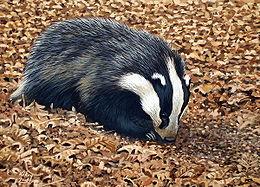Scientific classification:
Kingdom (Regnum): Animalia
Phylum (Phylum): Chordata
Class (Classis): Mammalia
Order (Ordo): Carnivora
Family (Familia): Mustelidae
The subfamily Melinae is named after the species, and it is the most famous member of the subfamily as well. To separate them from the other members of the subfamily they are often called european badger.
Distribution: They populate a huge area in Eurasia between the Atlantic and the Pacific ocean, incuding the British Isles and Japan. Vietnam is the border of their range in the south. They are native to almost all of Europe, except the islands far from the continent, like Corsica, Sardenia, Sicily and Cyprus.
Habitat: Badgers mainly live in forests, sometimtes they can be seen in cities. Erdős területeket kedvel, olykor városi parkokban is előfordul. They can be found at an altitude of up to 2000 meters in mountainous regions.
Morphology, physical description: Mammals (mammalia) are members of a class in possession of mammal glands, functional in mothers feeding offspring. They are homoiothermic, due to their evolved endothermic system. It means they have a near constant and relatively high body temperature, and most of them have some kind of hair to help preserving it. Their heart is divided into two halves by a septum, and it has four chambers. They have red blood cells lacking a nucleus and organelles, a special type of jaw joints, three middle ear bones, specialised teeth and evolved nerve system.
Mammals have an internal skeleton. It contains many bones and relatively few cartilages, compared to other vertebrates. The number of the bones may differ significantly among different types of mammals, but it usually exceeds 200, sometimes even 300.
The badgers measure about 90 cm in body length (15 cm of the total length is the tail length) and they weigh 15-20 kg. Males are somewhat bigger than females. It’s fur has very specific markings: the belly is black, but it’s back is silvery-grey. The badger’s head is white with black bands extending from the nose tip through the eyes to the ears.
Diet: During saytime it hides in the tundergrowth, but it looks for food in open areas. They are gluttonous omnivores, the main food sources are invertebrates, smaller vertebrates (birds, reptiles, rodents), seeds, fruit, roots and mushrooms.
Behaviour: Badgers can be easily recognised by their typical, noisy movement, altough it’s hard to spot due to its wariness. They spend the day in their dens, they are mostly active after sunset. In some regions, like Siberia or North-Europe, they sleep during winter. Badgers were thought to be lonely, only the recent researches showed thet they are highly social. They live in small clans, containing maximum 12 members, in huge dens.
Reproduction: They mate from winter till late summer, but the growth of the embryo may pause because of the 2−9 month period of delayed implantation. 11-12 months after mating they usually yean 2-6 cubs. Sexual maternity is attained at the age of 12 months on average. Their lifespan is maximum 16 years.
Role in the ecosystem: Badgers may cut down on unwanted pests, since they eat insects and carrion. Sometimes they damage crops, such as corn and oats, and peoples' vegetable gardens.
Role in the soil: The dens made by the badgers have a great impact on the ground. The sleeping chambers can be found 10 meters away from the entrance, about 2-3 meters under the ground, and there are many other chambers for different uses.The dens can be used by generations for over 100 years. Usually they stick to their burrows even the environment is no longer suitable for them. The den is growing continuously during the time, it’s range can even reach several acres. A den found in England had 879 meters of tunnel, 50 chambers and 178 entrances. By guess it was made by moving 70 tons of soil.
Conservation status: Badgers are rated ’least concern’, they aren’t protected in Hungary.
Relationships with humans: Their hairs were used for making pouches and other pieces of equipment, and were great material brushes. It’s fat was used as shoe polish. Badger meat can be eaten.
http://animaldiversity.ummz.umich.edu/site/accounts/information/Meles_meles.html
http://hu.wikipedia.org/wiki/Borz
http://hu.wikipedia.org/wiki/Eml%C5%91s%C3%B6k
